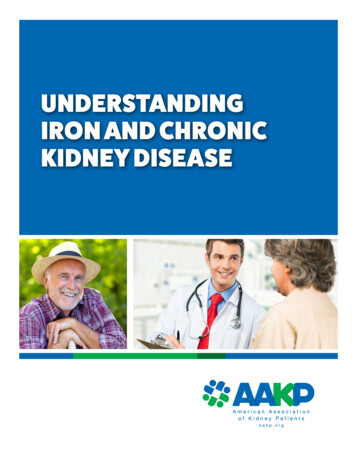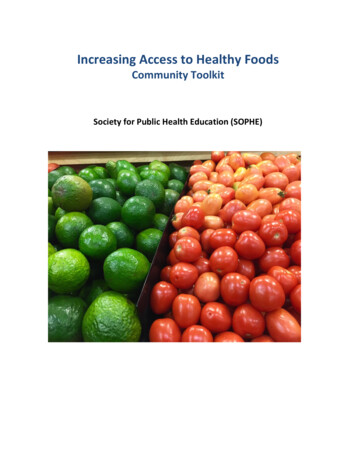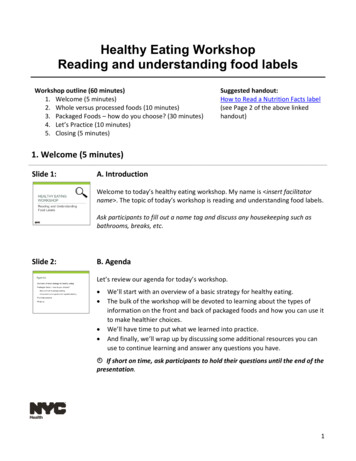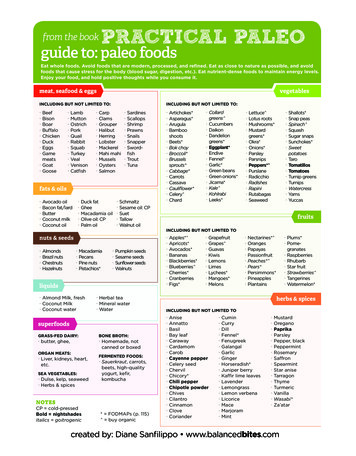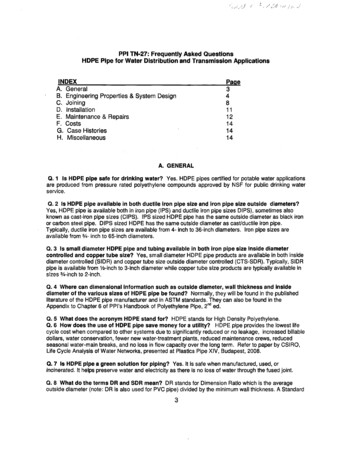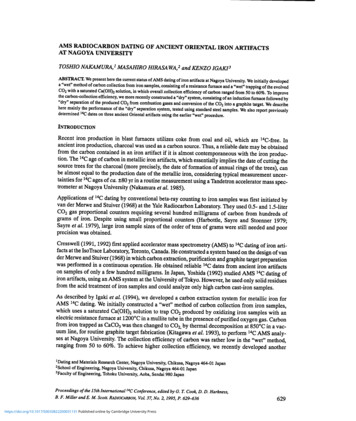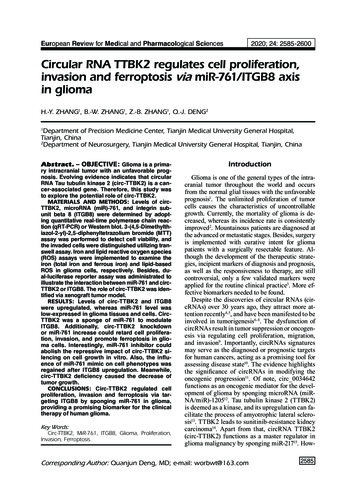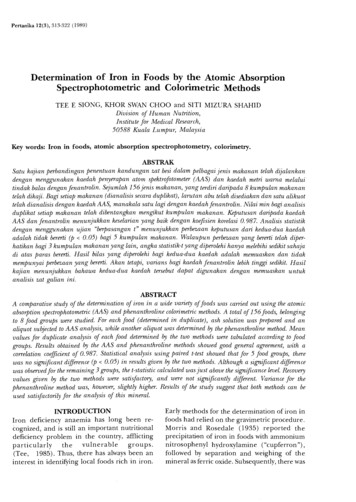
Transcription
Pertanika 12(3), 313-322 (1989)Determination of Iron in Foods by the Atomic AbsorptionSpectrophotometric and Colorimetric MethodsTEE E SIONG, KBOR SWAN CHOO and SIn MIZURA SHAHIDDivision of Human Nutrition,Institute for Medical Research,50588 Kuala Lumpur, MalaysiaKey words: Iron in foods, atomic absorption spectrophotometry, colorimetry.ABSTRAKSatu kajian perbandingan penentuan kandungan zat besi dalam pelbagai jenis makanan telah dijalankandengan menggunakan kaedah penyerapan atom spektrofotometer (AAS) dan kaedah metri wama melaluitindak balas dengan fenantrolin. Sejumlah 156 jenis makanan, yang terdiri daripada 8 kumpulan makanantelah dikaji. Bagi setiap makanan (dianalisis secara duplikat), larutan abu telah disediakan dan satu alikuottelah dianalisis dengan kaedah AAS, manakala satu lagi dengan kaedah fenantrolin. Nilai min bagi analisisduplikat setiap makanan telah dibentangkan mengikut kumpulan makanan. Keputusan daripada kaedahAAS dan fenantrolin menunjukkan keselarian yang baik dengan koefisien korelasi 0.987. Analisis statistikdengan menggunakan ujian "berpasangan t" menunjukkan perbezaan keputusan dari kedua-dua kaedahadalah tidak bererti (P 0.05) bagi 5 kumpulan makanan. Walaupun perbezaan yang bererti telah diperhatikan bagi 3 kumpulan makanan yang lain, angka statistik-t yang diperolehi hanya melebihi sedikit sahajadi atas paras bererti. Hasil &ilas yang diperolehi bagi kedua-dua kaedah adalah memuaskan dan tidakmempunyai perbezaan yang bererti. Akan tetapi, varians bagi kaedah fenantrolin lebih tinggi sedikit. Hasilkajian menunjukkan bahawa kedua-dua kaedah tersebut dapat digunakan dengan memuaskan untukanalisis zat galian ini.ABSTRACTA comparative study of the determination of iron in a wide variety of foods was carried out using the atomicabsorption spectrophotometric (AAS) and phenanthroline colorimetric methods. A total of 156 foods, belongingto 8 food groups were studied. For each food (determined in duplicate), ash solution was prepared and analiquot subjected to AAS analysis, while another aliquot was determined by the phenanthroline method. Meanvalues for duplicate analysis of each food determined by the two methods were tabulated according to foodgroups. Results obtained by the AAS and phenanthroline methods showed good general agreement, with acorrelation coefficient of 0.987. Statistical analysis using paired t-test showed that for 5 food groups, therewas no significant difference (p 0.05) in results given by the two methods. Although a significant differencewas observed for the remaining 3 groups, the t-statistic calculated was just above the significance level. Recoveryvalues given by the two methods were satisfactory, and were not significantly different. Variance for thephenanthroline method was, however, slightly higher. Results of the study suggest that both methods can beused satisfactorily for the analysis of this mineral.INTRODUCTIONIron deficiency anaemia has long been recognized, and is still an important nutritionaldeficiency problem in the country, afflictingparticularlythevulnerablegroups.(Tee, 1985). Thus, there has always been aninterest in identifying local foods rich in iron.Early methods for the determination of iron infoods had relied on the gravimetric procedure.Morris and Rosedale (1935) reported theprecipitati0n of iron in foods with ammoniumni trosophenyl hydroxylamine ("cupferron"),followed by separation and weighing of themineral as ferric oxide. Subsequently, there was
TEE E. SIONG, KHOR SWAN CHOO AND SITI MIZURA SHAHIDa switch over to colorimetric procedures for thedetermination of this mineral. Simpson et at.(1951) estimated iron based on colour development with thioglycolii:: acid. Two years later,Leong (1953) reported the use of ortho-phenanthroline for colour development. This colourreagent, as well as bipyridyl, continued to beused by subsequent investigators (Tee et at.1987). Determination of iron using atomicabsorption spectrophotometry (AAS) has beenintroduced in recent years.The choice of either the AAS or colorimetric method has relied on various factors,including availability of the required instrumentas well as expertise. For various reasons, it wouldbe important to determine if the AAS andcolorimetric methods give comparable results.Different laboratories participating in a jointprogramme for the analysis of iron using thetwo different methods would need to determine if the results obtained are comparable.Before switching over to a newly purchasedatomic absorption spectrophotometer, a laboratory would need to find out if the results to beobtained would be comparable to those previously obtained with the colorimetric method.On the other hand, in a laboratory using theAAS method, it may be necessary to switch tothe colorimetric method if the spectrophotometer breaks down for a considerable lengthof time.This report presents results of a comparative study of the determination of iron ina wide variety of foods using the AAS. andcolorimetric methods. It is hoped that the resultswould indicate clearly if significant differencesare given by the two analytical procedures.This could be of assistance to laboratoryworkers intending to use either methods, suchas in situations mentioned above. The studywas carried out together with a comparativestudy of the determination of calcium usingthe AAS and titrimetric methods (Tee etat. 1989).MATERIALS AND METHODSSamples offoods from various food groups werepurchased from local markets and retail storesfor analysis. Wherever applicable, refuse in eachfood item was removed and its proportion in314the food determined. The edible portionswere blended and aliquots taken for analysis.An amount of 5-15 g of the homogenizedsample was dried in an air oven at 105 C for 3hours. The dried sample was next charred untilit ceased to smoke. The charred sample wasthen ashed in a muffle furnace at 550 C untila whitish or greyish ash was obtained. The ashwas treated with concentrated hydrochloric acid,transfered to a volumetric flask and made upto 50 ml. For each food studied, two ash solutions were prepared, i.e. duplicate analysis wascarried out. An aliquot of each ash solution wasused for the determination of iron by the AASmethod and another aliquot by the colorimetric method.For the AAS method, a Varian Atomic Absorption Spectrophotometer model 175 withan air- acetylene flame was used. Wavelengthwas set to 248.3 nm for solutions with ironconcentrations ranging from 2.5 to 10 Ilg/ml,or 327.0 nm for concentrations ranging from25 to 100 Ilg/ml. Ferric nitrate solution foratomic absorption spectrophotometry (BDH)was used as standard. A calibration curve withat least 4 concentrations of iron within theanalytical range was prepared. Concentrationsof iron in test solutions was calculated from thestandard curve prepared. For each ash solution, at least three readings were obtained andthe average calculated.In the colorimetric procedure, an aliquotof the ash solution was reacted with 1,1 O-phenanthroline hydrochloride and the resulting redcomplex read in a uv-vis spectrophotometer at510 nm. For each ash solution, two tubes wereprepared for reaction with the colour reagentand the average absorbance reading used forcalcultion. A standard curve was prepared usingferric nitrate solution and used for calculationof iron in the test ash solutions. Analytical gradeiron wire and ferrous ammonium sulphate havealso been found to be suitable for use. Thelatter tend to be unstable and turn yellow onkeeping.Recovery studies were performed byadding a known amount (about 50% of theestimated iron content of the food) of ironstock standard to the food. Preparation of ashsolution and analysis of iron using the AAS andPERTANlKA VOL 12 NO.3, 1989
DETERMINATION OF IRON IN FOODS BYTHE AAS AND COLORlMETRIC METHODScolorimetric methods were carried out as described above.Details of the AAS and colorimetricmethods used are described in Tee et al. (1987).All results were expressed as per 100 g edibleportion of the food. Mean values for duplicateanalysis of each food determined by the twomethods were calculated and results tabulatedaccording to food groups. For each food group,the paired t-test was carried out using theABSTAT statistical programme to determineif the two methods gave significantly differentresults. Correlation coefficient was calculatedusing the same programme. Analytical processstandard deviations of the two methods werecompared using the F-ratios method (Wernimont 1985).RESULTS AND DISCUSSIONA wide variety of foods from various food groupswere studied, to determine if the nature of thefoods affected the results obtained. A total of156 foods, belonging to 8 food groups werestudied. Mean values for duplicate analysis ofeach food determined by the AAS and phenanthroline colorimetric methods were tabulatedaccording to food groups (Tables 1 to 8). In allthe tables, the English names of the foods aregiven, and arranged in alphabetical order.Where these names may be ambiguous orunclear, or when the English names are notknown, the local names of the foods are included. The scientific names of the foods arealso tabulated where appropriate.There was generally good agreement inthe results obtained by the two methods, as canbe seen from Tables 1 to 8, and the scatterdiagram plotting 150 pairs of results obtained(Fig. 1). The remaining 6 pairs were omittedfrom the plot as they were much higher thanthe majority of the values obtained. A goodcorrelation coefficient of 0.987 was obtainedfor all 156 pairs of results.Results of paired t-test for all food groups.studied (Table 9) showed that for 5 food grou ps,there was statistically no significant difference(p 0.05) in iron content determined by theAAS and colorimetric methods. For the remaining 3 groups, a significant difference in resultswas obtained. However, in all these cases, thet-statistic calculated was small, just above thesignificance level.Determination of spiked iron in the foodswas carried out in 10 separate studies. Table 10TABLE 1Iron in cereals and products as determined by the atomic absorptionspectrophotometric and colorimetric methodsmg Fe/l00 g edible portionAAS methodEnglish/local .374.108.44Bread, coconutBread, ryemealBread, whiteBread, wholemealNoodle laksa, thick, dryNoodle laksa, thick, wetOats, processedOats, rolledRice, brokenRice bran, coarseRice noodle (Loh-seejun)Wheat flour, high proteinWheat flour, wholemealWheat germColorimetric 95.108.148.67Each value is the mean of duplicate analysisPERTANIKA VOL. 12 :-.JO. 3, 1989315
TEE E. SIONG, KHOR SWAN CHOO AND SIT! MIZURA SHAHIDTABLE 2Iron in legumes and products as determined by the atomic absorptionspectrophotometric and colorimetric methodsmg Fe/100 g edible portionAAS methodColorimetric methodBaked beans, canned2.112.11Chickpea/Common gramDhal, Mysore4.995.145.463.095.85Soya bean, fermented (Tempeh)Soya bean cake (Tau-kua), spiced5.322.484.46Soya bean cake (Tau-kua)Soya bean curd, sheets (Fucok)Soya bean curd, strands (Fucok)2.277.069.012.538.2310.02Soya bean curd ya bean curd (Tau-hoo-pok)Soya bean milk, packetSoya bean milk, unsweetenedSoya bean noodles1.38Each value is the mean of duplicate anal :sisTABLE 3Iron in nuts and seeds as determined by the atomic absorptionspectrophotometric and colorimetric methodsmg Fe/lOO g edible portionScien tific nameAAS methodColorimetric methodAlmondPrunus amygdalus3.003,34Arecanut shavingsBrazil nutA reca catechu5.441.34CandlenutCashew nutAleurites moluccana1.73Anacardium occidentale5.95Chestnut, ChineseCastanea spp.0.916.620.96Coconut flesh, oldCocos nuciferaCoconut flesh, youngCoconut milkCocos nucifera1.210.491.440.51Coconut waterCocos nucifera1.000.030.05Lotus seedPeanut butterA rachis hypogeaSesame seed/Gingelly seedWalnut, driedJuglans regia5.052.63Watermelon seed, black, driedCitrullus vulgaris5.98English/local nameBertholletia excelsaCocos nuciferaNelumbo nuciferaSesamum indicumEach value is the mean of duplicate analysis316PERTANlKA VOL. 12 NO.3, 19892.881.947,392,343;631.182.031.864.622.557.86
DETERMINATION OF IRON IN FOODS BYTHE AAS AND COLORIMETRIC METHODSTABLE 4Iron in vegetables as determined by the atomic absorptionspectrophotometric and colorimetric methodsmg Fe/IOO g edible portionEnglish/local nameScientific nameAAS methodColorimetric methodAsam gelugor, shootsGarcinia atroviridisAsparagus, cannedAsparagus oJJicinalis7.066.91Asparagus, freshAsparagus oJJicinalis0.530.59BroccoliBrassica oleracea0.470.71CemperaiChampereia griJJithii1.961.90Chilli, smallCapsicum annuum0.681.24Chives, ChineseAllium odorum0.620.70Coriander leavesCoriandrum sativum3.862.99Cucumber, hairyCucumis spp.0.150.15Drumstick, fresh podsMoringa oleifera0.270.27Garlic, bulbsAllium sativum0.480.84Garlic, plantsAllium sativum0.310.42Gourd, bottle/CalabashLagenaria vulgaris0.220.27Kadok, leavesPiper sarmentosum2.261.73LeekAllium porrum0.330.280.840.98Mushrooms, grey oyster, fresh0.880.99Mustard leaves, Chinese (Sawi)Brassica juncea1.351.32Mustard leaves, Indian (Kai-coy)Brassica juncea1.461.45ParsleyPetroselinum crispum9.9010.25Peas, garden, fresnPisum sativum0.750.78Salted vegetable1.972.05Seaweed, agar (Agar-agar)5.335.28Seaweed, dried22.9421.71Spinach, CeylonBasella rubra0.881.07Spinach, redAmaranthus gangeticus2.642.44Spinach (Bayam duri)Amaranthus spinosus1.69LOSWaterchestnutScirpus tuberosus0.320.39Winter melon / \Vax gourdBenincasa hispida0.140:21Wolfberry leavesLycium chinense3.112.70Yam bean (Sengkuang)Pachyrrhizus erosus0.260.34Each value is the mean of duplicate analysisPERTANIKA VOL. 12 NO.3, 1989317
TEE E. SIONG, KHOR SWAN CHOO AND SITI MIZURA SHAHIDTABLE 5Iron in fruits as determined by the atomic absorptionspectrophotometric and colorimetric methodsmg Fe/IOO g edible portionEnglish/local nameScientific nameAAS methodColorimetric methodAvocadoPersea americana0.490.57Banana (Pisang kelat)Musa sapientium0.380.53BinjaiMangifera caesia0.300.30Cashew appleAnacardium occidentale0.230.27Custard appleAnnona squamosa0.360.36Date, driedPhoenix dactylifera0.800.76DukuLansium domesticum0.230.270.580.24GrapefruitCitrus paradisi0.260.22JeringPithecellobium lobatum0.740.70Citrus microcarpa0.150.17LycheeLitchi chinensis0.200.21Mango (Bacang gelok)Mangifera foetida0.220.22Mango (Kwini)Mangifera odorata0.310.27Nutmeg, freshMyristica fragrans0.220.37OliveOlea europaea1.121.12Orange, MandarinCitrus reticulata0.200.20Pear, greenPyrus communis0.200.23Persimmon, driedDiospyros kaki0.991.10Pineapple syrup, cannedAnanas comosa0.280.29Prunes, driedPrunus spp.1.071.03PulasanNephelium mutabile0.120.17RambaiBaccaurea motleynana0.210.19SoursQPAnnona muricata0.320.37StrawberryFragaria grandiflora0.210.20Water appleEugenia aquea0.170.17Fruit cocktail in syrup, cannedLimemus (Umau kasturi)Each value is the mean of duplicate analysis318PERTANlKA VOL. 12 NO.3, 1989
DETERMINATION OF IRON IN FOODS BYTHE AAS AND COLORIMETRIC METHODSTABLE 6Iron in meat and eggs as determined by the atomic absorptionspectrophotometric and colorimetric methodsmg Fe/l00 g edible portionAAS methodColorimetric 33.483.670.730.362.17Beef extractBeef liver, rendang, cannedChicken curry, cannedChicken feet, debonedChicken gizzardChicken heartChicken intestinesCorned beefDuckDuck, roastedDuck egg, salted, yolkDuck egg, yolkMutton curry, cannedOx mawTurtle egg, whiteTurtle egg, .503.820.870.332.65Each value is the mean of duplicate analysisTABLE 7Iron in fish and fish products as determined by the atomic absorptionspectrophotometric and colorimetric methodsmg Fe/ I 00 g edible portionScientific nameEnglish/local nameAnchovy, cleanedCuttlefish, driedFish ballsFish bladder, driedFish bladder, friedFish curry, cannedFish roeFish sauce (Budu)Hairtail scad, driedLive crab/Swimming crabOyster sauceOysterPrawn paste (Hay-ko)Sea crab/Blue crabShark's fin, driedShrimp, fermented (Cincalok)Threadfin, driedYellow banded trevally, driedAAS methodStolephorus commersoniiSepia officinalisMegalaspis cordylaOstrea spp.Ostrea spp.Polynemus indicusSelaroides 0.754.9921.560.503.041.221.072.05Colorimethc 4.9622.310.612.521.070.961.68Each value is the mean of duplicate analysisPERTA:--IlKA VOL. 12 NO.3, 1989319
TEE E. SIONG, KHOR SWAN CHOO AND SIT! :VIIZURA SHAHIDTABLE 8Iron in miscellaneous foods as determined by the atomic absorptionspectrophotometric and colorimetric methodsmg Fe/100 g edible portionScien tific nameAAS methodAnise seed, dr.iedCardamonCinnamonCoffee mixture, powderCorianda seedsCumin seeds, blackCumin seeds, whiteCurry powderFenugreek seedsGalangalHoneyJam, egg (Seri kaya)Jam, pineappleJelly crystalsMalted milk powderMarmaladeMilk-based diet supplement, powderPimpinella anisumEleltaria cardamomum100.5320.562.17Pepper, powder, whiteSugar, brownSugar, coconut palm (Gula Melaka)Piper nigrumSugar cane juiceTamarind paste (Asam Jawa)Treacle, blackYeast, driedSaccharum oJfzcinarumTamarindus indicaEnglish/local nameCinnamomwn 51.160.1617.250.09Coriandrum sativllmNigella sativaCuminum cyminumTrigonella foenum-graecumLanguas yces cerevisiaeColorimetric 4416.9427.40Each value. is the mean of duplicate analysisTABLE 9Paired t-test of iron concentrations determined by the atomicabsorption spectrophotometric and colorimetric 0.9732.0330.8270.3762.7650.1912.112Food groupCereals and productsLegumes and productsNuts and seedsVegetablesFruitsMeat and eggsFish and fish productsMiscellaneousI at p 0.05, statistically significant, not statistically significant320PERTANlKA VOL. 12 NO.3, 1989Statisticalsignificance]S.2N.S 3N.S.N.S.N.S.S.N.S.S.
DETERMINATION OF IKON IN FOODS BYTHE AAS AND COLORIMETRIC METHODSTABLE 10Recovery values obtained by the atomic absorptionspectrophotometric and colorimetric methodsAAS methodColorimetric methodNumber of determinations1010Mean SDCoefficient of variation84.2 9.4%90.7 11.2%11.112.3uiE'Ii 10510152025AtomIc absorption spectrophotometric methodFig. 1Iron concentration determined by the AAS and colorimetric methods (mg ironper 100 g edible portion).n 150 (results for 6 foods not included)shows that mean % recovery obtained by thecolorimetric method was closer to 100 thanthat for the AAS method. Statistically however,there was no significant difference (p 0.05)in mean recovery values given by the twomethods.Pooled standard deviation calculated forall the 156 foods studied was 0.39 for the AASmethod and 0.63 for the colorimetric method.Comparing the variance obtained for all foods,the observed F-ratio was calculated to be 2.66.Variance for the colorimetric method was thussignificantly higher than that for the AASmethod (p 0.05).CONCLUSIONSResults of thi's comparative study do not showsignificantly different iron concentrations for awide variety of foods between the AAS and theo-phenanthroline colorimetric methods. Bothmethods were found to give satisfactory recovery values. Variance for the colorimetric methodwas however slightly higher than that for theAAS method. Either method can, therefore, bePERTANlKA VOL. 12 NO.3, 1989321
TEE E. SIONG, KHOR SWAN CHOO AND SITI MIZURA SHAHIDused satisfactority for this analysis. T h ere are,however, other considerations in the choice ofa method for use.In the colorimetric method, several stepsare required in preparing solutions for readingin a spectrophotometer. All glassware, chemi cals, and water used should be iron-free toprevent contamination to the test solutions.Fortunately, the red colour complex forme d isstable for a number of hours. T h e procedur eis also relatively much cheaper, requiring onlya low-cost spectrophotometer operating in thevisible range. In the hands of a ca reful work r,the method can perform satisfacto rily.The AAS method, on the o the r h a nd ,requires the purchase of a high-cost spec tro photometer which is also rather expensive tooperate and maintain. It is however, a relativelysimpler procedure. The ash solu tion can beused directly for spraying in the spectro photometer, after the instrument has b eenappropriately set up. It would be the metho dof choice, provided the required budge t isavailable.Compared to a similar comparative studyon calcium determination in foods (Tee et ai.,1989), it has been observed that th e re weremore variations between iron content given bythe AAS and colorimetric methods. Correla tion coefficient for this study was sligthly lowerand recovery values were also lower with largercoefficient of variation. Process variation forthe colorimetric method was also found to behigher. These relate to the observation hatiron determination is rather prone to contami nation from the environment. Various precau- .tions, requiring greater degree of care and skillin the laboratory worker, have to be take n tomin imise this.322ACKNOWLEDGEMENTSWe would like to acknowledge the assistance ofMs Chin Suan Kee of th is Division and Ms OngChi ng Ching, Tun ku Abdul Rahman College,Kuala Lu mpur, in carrying out some of theanalyses. We thank D r. M.Jegathesan, Directorof the Institute fo r Medical Research for per rmSSlOn to publish the results of this study.REFERENCESLEONG, P. c. 1953. T he Nu tritive Vali ne of Coco nut Todd y. Br. j. N utl". 7 : 253-259.MORRIS, J.P. and J.L. ROSEDALE. 1935. The Mi ne ral Co ntent of Some T ropical Foods. Mal. Med.j. 10 : 1-6.SI:VIPSO , LA. , A. Y. CHOW and c. c. SC)H . 1951. AStudy of the N utritional Value of Some Varietiesof Malaysian ri ce. Bulletin New Series No.5,Institu te for Medical Research, Kuala Lumpur.T EE, E.S. 1985. Nutritional Anaemias: Spectrumand Perspectives with Relevance to Malaysia. Spe cialist and Reprod uctive Research Centre, Na tional Po pulation and Family Development Board,Kuala Lu mpur.TEE, E.S., S. SIT! MIZURA, R. KULADEVAN, S.l. YOUNG,S.c. KJ.IOR and S.K. CHI N (editors). 1987. Lab o ratory Procedures in Nutrien t Analysis of Foods.Division of Human N u trition , Institute for Medi cal Re search, Kuala Lumpur, pp. 85-88 & 92-96.TEE, E.S., S.c. KJ10R and S. SITI MIZURA. 1989. De termination of Calcium in Foods by the Atomi.cAbso rp tion Sp ctrophotometric and TitrimetricMethods. Perlanika 2(3): 303-31l.WERNIMONT, C T. 1985. Use of Statistics to Developan d Evaluate Analytical Me thods. Association ofO fficial Analytical Chemists, Virginia.PERTANI KA VO L. 12 NO. 3, 1989(Received 6 June, 1989)
interest in identifying local foods rich in iron. Early methods for the determination of iron in foods had relied on the gravimetric procedure. Morris and Rosedale (1935) reported the precipitati0n of iron in foods with ammonium ni trosophenyl hydroxylamine ("cupferron"), followed by separation and weighing of the mineral as ferric oxide.


